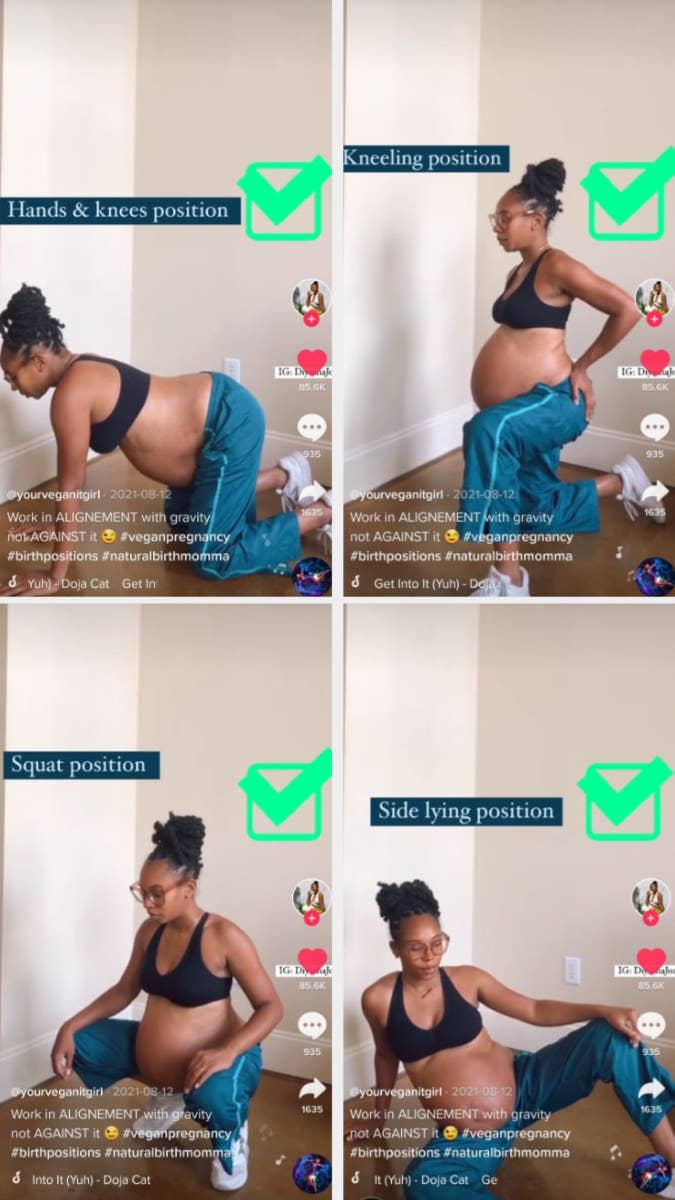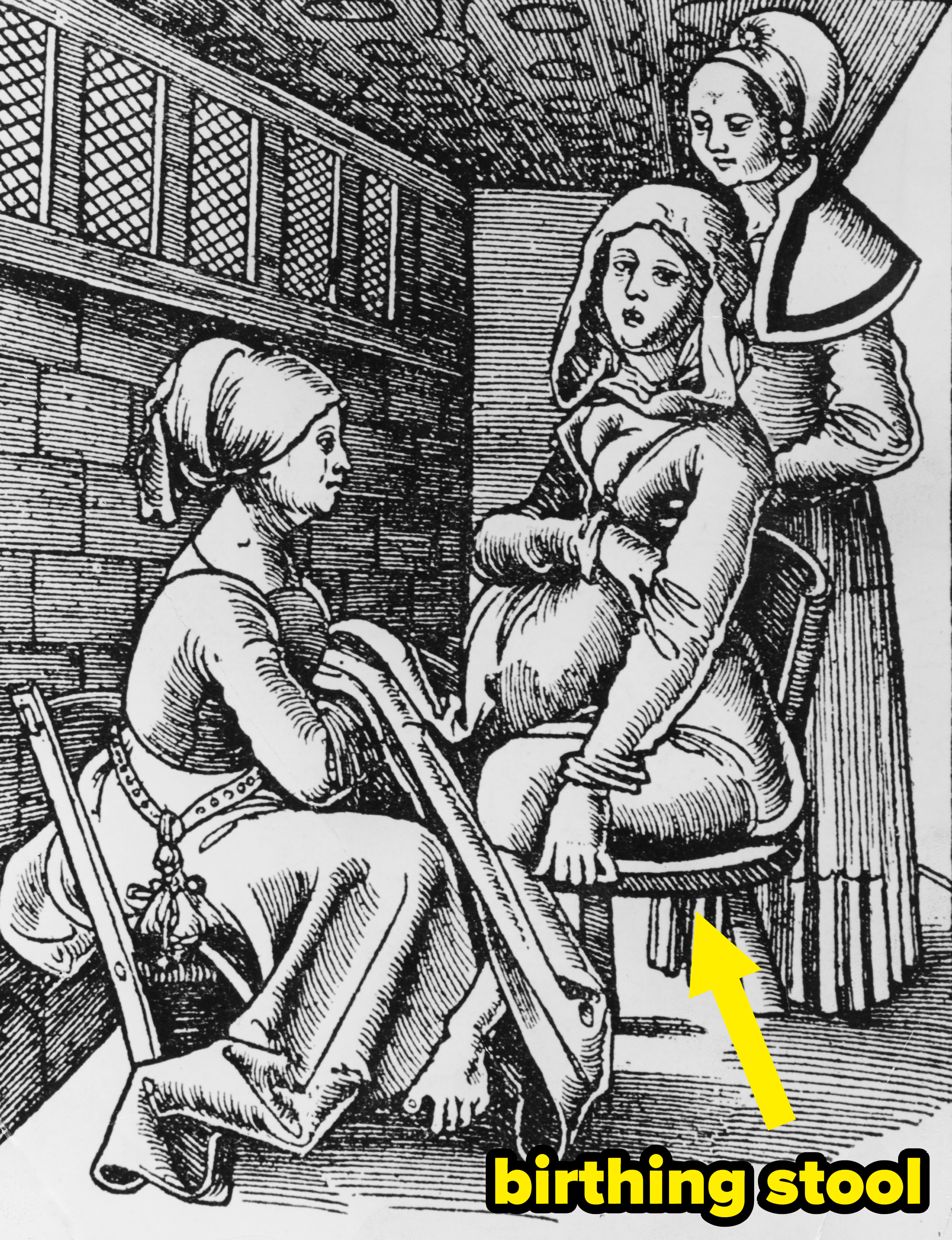Amassing nearly 1 million views, Diyasha's video shows herself in four different birth positions: a hands-and-knees position, a kneeling position, a squatting position, and a side-lying position.

Many viewers were quick to comment in response. Some were in jest (one person wondered, "Why can't we just lay eggs like chickens?"), but the majority expressed agreement, interest, and their stories of childbirth.

To find out how she learned about these positions and why she decided to use them when giving birth at home, BuzzFeed reached out to Diyasha. "I've always been a natural-type person," she said, "And just being a Black woman understanding the Black maternal mortality rate in hospitals, I was like, I'll look, find resources, and see what's available, then just build around it."
When it comes to how and when to decide to get into one of these positions, Diyasha explained that it comes down to natural instinct when it's time to push: "I think people are confused when they hear the word labor. When I'm talking about childbirth positions, I mean at the moment when you feel the urge to push. With my son, I wasn't in a squat position the whole 18-hour labor. When it's time to push the baby out, get into your position."
Diyasha was also surprised with the reception of her video, noting that many people thanked her for putting the information out there: "There were so many people who thought it made sense when you see it, but because you've only seen things done this one way, you think that is the standard."
To learn more about effective childbirth positions, BuzzFeed spoke with Sara Twogood, MD, a board-certified OB-GYN in Los Angeles and co-founder of Female Health Education and the online magazine Female Health Collective.

"The most effective way to push out a baby is the way the patient most effectively pushes! That can be lying on the back or side, on hands and knees, or squatting," Dr. Twogood explained, before elaborating on why certain positions could be less advantageous than others.

"Sitting up is not usually the best position because of the angle of the pubic bone — the baby needs to work its way underneath the pubic bone — so it is harder to negotiate than squatting or lying."

BuzzFeed also specifically asked Dr. Twogood about any pros or cons of different positions. She confirmed, "No one position has been shown to be optimal or detrimental to laboring. In general, changing positions often during labor is thought to be helpful. That might mean walking, then squatting, then hands and knees, then lying flat and resting."

If the most effective childbirth position is the one most effective for the person giving birth, then why is lying on your back the default? BuzzFeed next spoke with Randi Hutter Epstein, MD MPH, a doctor, medical writer, and the author of Get Me Out: A History of Childbirth From the Garden of Eden to the Sperm Bank and Aroused: The History of Hormones and How They Control Just About Everything.

Since ancient times, midwives have delivered babies. But by the 1600s, Dr. Epstein said, "Doctors started having turf battles with midwives, saying, 'We're better at delivering babies; this is a medical thing.'" Over time, childbirth shifted from the domain of midwives to doctors. In the 1800s, as medicine became professionalized, more standards were enforced. Medical schools only accepted men, and midwives were forbidden from practicing in hospitals. By 1930, 75% of women gave birth in hospitals. That percentage swelled to 90% by 1950, and now roughly 98% of women give birth in hospitals.

As for midwifery today, laws differ by state. In states that don't offer licenses, midwives are at risk for criminal prosecution for unlicensed healthcare if they help deliver babies — something that posed a challenge for Diyasha's first home birth: "I wanted an all-Black birth team, but it ended up not being that way because I live in North Carolina, and in North Carolina, it is technically illegal for you to have a midwife."
Overall, many norms and practices regarding childbirth stem from cultural influences. Fortunately, King Louis XIV was not one of those influences. While he did have a childbirth fetish, Dr. Epstein said it's a myth that he required women to give birth lying on their backs. However, French physician François Mariceau — who practiced while Louis XIV was king — is sometimes accredited with normalizing lying on your back.

As childbirth was medicalized, Mariceau swapped birthing stools for beds and, in 1668, published a book on obstetrics. In it, he wrote that women were able to better breathe and preserve their strength (to handle pain) when on beds lying on their backs. The book established obstetrics as a science and was then translated from French to several different languages.

In the end, the best childbirth position is the one that works best for the person giving birth. If you are interested in trying a specific birthing position and plan on giving birth in a hospital, the best course of action is to speak to your doctor about it beforehand so that you're on the same page.

As for Diyasha's intentions with sharing her video, she expressed, "I just want people to know that there are more options out there and to give them a newfound perspective on what they're allowed to do. At the end of the day, it's your body; it's your choice. You can choose to labor this way. You can choose to set the scene and set the tone for how it is that you want to birth and bring your children into this world."
She concluded, "I really want to empower women to find their voice, even if it's with their partner or friend or somebody that can advocate for them. I think that's the beauty of me being able to have all three kids at home and have different, but still positive, experiences. I can share different things in order to be like, you know, I did it — you can do it."
For more on the following topics, check out these resources:
• Positions for Labor and Birth by Allina Health
• Labor Support Resources by Childbirth Connection
• What Is a Birth Center? by the American Association of Birth Centers
• Resources for Choosing a Place of Birth by Childbirth Connection
• Midwifery Resources and Information by State by the Midwives Alliance North America
